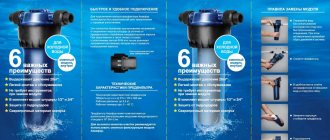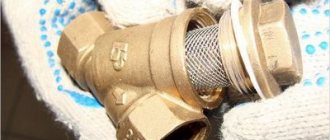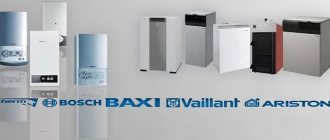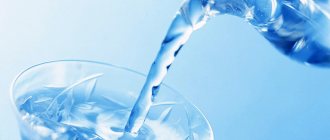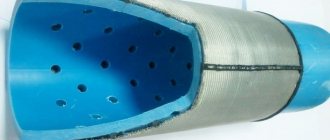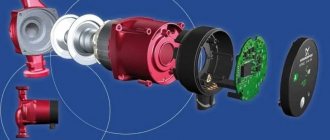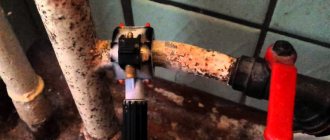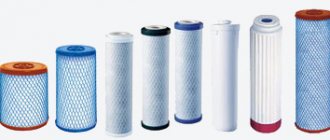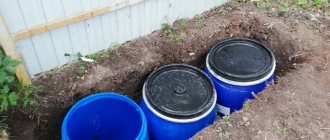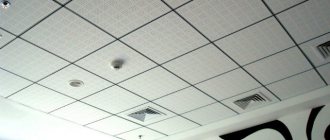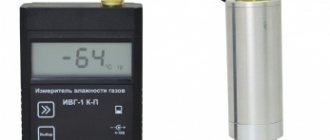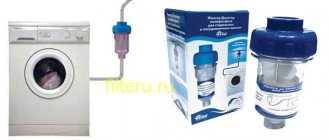The quality of tap water leaves much to be desired, so it is not advisable to consume it as food; it must be subjected to additional purification. The water coming from the tap often has a foreign taste and smell - this can greatly spoil the dish, and it can be completely disgusting to drink. Largely for this reason, many people install special filters under the sink that remove additional impurities from the water that spoil its quality.
They remove harmful substances from water, including heavy metals, chlorine, and large impurities such as squeak. These designs are installed directly in the kitchen sink, due to which clean water will be obtained instantly, unlike pitcher-type filters.
Features of the design of filters for washing
Despite the fairly simple design and principle of operation, filters of this type contain a large number of components and elements. Therefore, installing a water filter yourself should be in accordance with the complete set of the product.
The composition of the filter part is determined by the user's choice. The number of cartridges and, accordingly, purification stages is from 2 to 6, and their type is selected in accordance with the quality of the source water. Since the cost of the filter directly depends on the number of stages, in some cases it is advisable to strengthen one direction of cleaning, saving on the other.
For example, if there is sand and other types of mechanical impurities in a liquid whose composition meets quality requirements, you can do without an iron removal cartridge by installing an additional sorption filter instead.
The under-sink filter may include:
- carbon cartridges for mechanical cleaning,
- deferrization,
- mechanical filters for solid suspensions,
- softeners for removing hardness salts,
- reverse osmosis membranes,
- mineralizers that optimize the composition of the liquid,
- UV lamps for disinfection.
In addition to cleaning modules, the design is equipped with:
- bracket-console for mounting on the wall,
- a device for connecting to a cold water supply pipeline (adapter or tee) with a valve installed at the insertion point and regulating the water supply,
- gaskets for connections,
- faucet installed on the sink.
For ease of use, the kit may include a storage tank that ensures water supply, despite the decrease in pressure when passing through filters and especially through a reverse osmosis membrane.
The contents of the reverse osmosis water filter may vary depending on the manufacturer and model.
Conclusions and useful video on the topic
This video will help you correctly determine the main differences and advantages of flow and reverse osmosis filters:
In the next video we will talk about reverse osmosis systems. Here are the specific results of measurements of the main water indicators:
In conclusion of the article, it should be noted that both categories of filters allow you to obtain water of the required purity. You can find suitable equipment for any water supply system, regardless of your budget.
The accuracy of the choice will be significantly influenced by a preliminary analysis of tap water. This will allow you to understand how hard the water is, which microelements are in excess, and which minerals are in short supply.
Would you like to talk about which filter was chosen and installed in the water supply system to prepare drinking water? Do you have useful information on the topic that may be useful to site visitors? Please write comments in the block below the text of the article, post photos and ask questions.
Installation site requirements
A special feature of the operation of such treatment structures is the ability to work with only one point of water consumption. Therefore, the installation of water filters in an apartment, and in some cases in a house, is carried out in the kitchen . The place under the sink is perfect for these purposes - the device is not in sight, but it is accessible for maintenance.
However, it is necessary to measure the dimensions of the free space and ensure that certain conditions are met at the stage of choosing a model:
- The structure should fit freely under the sink without squeezing or squeezing.
- All flasks should be positioned so that it is easy to replace the cartridge.
- Plumbing components (valves, sink drain check valve, etc.) must remain in a freely accessible area for inspection and repair.
Despite the location of the filter under the sink, there is still enough free space under it
Criterias of choice
When choosing a water filter for your home, you must consider the following number of criteria:
- Purpose - what specific filtering functions the device should perform - rough cleaning, softening, disinfection, etc.
- Installation location: under the sink, on the faucet, etc.
- Dimensions - must correspond to the installation location so that there are no problems during installation and maintenance.
- The operating principle is flow or reverse osmosis.
- Stationary with the possibility of updating filter elements or one-time use.
- Productivity - depends on the volume of flowing water in a given period of time or the number of people living in the house.
- Price.
- Manufacturer.
On a note! The most convenient to use and the best in terms of degree of purification is a stationary osmotic type filter. To extend its service life, it is enough to replace the filter elements in a timely manner. At the same time, the osmotic system purifies water to the greatest extent from various types of polluting factors - mechanical particles, salts, dissolved substances and microorganisms.
The choice of filter is influenced by both the initial and required quality of consumed water Source make-self.net
Which water filter is best to install?
There are a huge number of them, and each of the filters has individual characteristics. Before making an immediate purchase and subsequent purchase, study information about their types and operating principles.
There are two main types of filters: pitcher
and
flow-through
. If installing a pitcher water filter allows you to purify the water only slightly, then a flow-through filter provides a higher degree of filtration. A pitcher water filter has a lower cost, which is explained by low productivity and slow cleaning. Also, jug filters cannot be included in a chain of several filter elements.
Installation of a flow-through water filter begins with connecting it to the water supply system. There may be some difficulties with this, but they are quite easily solved.
In turn, flow-through hydraulic filters are divided into 3 subgroups:
- filter attachments for water taps;
- filters with possible connection to the tap;
- stationary water filters.
When using combined hydrofilter attachments, you can significantly increase the degree of purification of tap water, but then their service life will be minimal. You will have to choose between frequent financial costs and the need for the most purified water at home.
Articles recommended for reading:
- Types of water filters and their characteristics
- Water quality standards depending on purpose
- How to drink water correctly: practical recommendations
Installation of a flow filter begins with connection to a water tap. This may take some time as it involves a more complex installation process . When installing a water purification filter, you will need a flexible hose.
Often, flow-through hydraulic filters are also used for electrochemical water purification, which significantly improves the quality of the liquid. Here, stationary structures are more suitable for you, since installing a stationary household flow filter will provide a high degree of cleaning. When installing, you should take into account the possibility of a group serial connection, which will several times increase the quality of the process of purifying the liquid from foreign impurities. Installation of a stationary household flow filter occurs with a connection to a general water supply system.
A stationary flow filter for water purification has one feature: the connection to the water supply network is identical to any other water supply equipment, which, in turn, eliminates the problem of the water filter breaking down.
The design of a stationary flow filter for water purification is also unusual. Most models have the ability to change cartridges. Of course, such hydrofilters are quite expensive compared to one-time models, however, this design will very soon pay for itself, because it is much easier to change the cartridge than to reinstall the filter for water purification.
The most common and convenient location of a flow filter for water purification is the space under the sink . The advantages of this installation are as follows:
- The filter does not take up kitchen space necessary for movement.
- The installation process itself takes less time.
- You can easily replace the cartridge.
There are models of water purification filters that are also installed under the sink, but instead of connecting to the main water tap, they have their own additional tap. Installing such a filter for water purification will require a little more time, since it will be necessary to drill a hole for the tap outlet with a diameter of 12 mm. In this case, it will be important to take care of the cold water supply system and install a tee outlet together with a filter for water purification. To do this you can:
- Make a cutout in the pipe and install a tee-bend into it.
- Use the tee bend as a clamp. Then you will need to clamp the tee bend onto the pipe above the cut hole.
All parts of the hydrofilter must ultimately be connected using flexible wiring. After directly installing the water purification filter, about 10 liters of water should be passed in order for the entire filtration system to be cleaned. Only after this can you use a filter to purify tap water.
Read material on the topic: Types of water filters and their characteristics
How to choose the right filter?
Since choosing a modern water filter for washing is not easy, you have to listen to the proven recommendations of specialists and experienced users.
Before purchasing, you should pay attention to the following factors:
- the amount of clean water consumed by apartment/house residents;
- water quality;
- availability of the necessary space under the sink.
These factors are important because the choice of the right model will depend on them. On average, one person consumes up to 3 liters of water, in its pure form and as part of food and drinks. Accordingly, you need to calculate the filter performance to suit the needs of the family.
Since only reverse osmosis options can boast the best indicators of water purity, you should first consider them. If their productivity is not enough, then you need to stop at flow models. It is reasonable to equip them with softeners and iron removal cartridges.
Clean water at any time is what the installation of filters is for. Modern replacement of filter elements will allow you to get safe water in your home
You also need to pay attention to the condition of the water supplied from the tap. If it is excessively hard, then you need a filter with a water softening function.
If the water supply system includes lines made of old cast iron pipes, then the incoming water will contain inclusions of large mechanical particles. It is not enough to clean such water from contaminants; you also need to remove excess amounts of iron from its composition. Why should you choose filters with iron removal?
If the water supply system in the house is autonomous and it already has a filter at the entrance to the house, for example, a bottom filter or a pre-filter, then the simplest flow filters will do. You just have to focus on the productivity of the technology.
Which water filter is best to install under the sink?
The best solution for any housewife, because after installing it you can forget about long filtration processes. You can pour filtered water straight from the tap.
Thus, installing a household water filter under the sink has the following advantages:
- instant filtration process;
- high-quality water purification;
- rare cartridge changes;
- constant provision of fresh, purified running water.
A sink water filter helps clean tap water from rust, chlorine and dissolved organic matter. This improves the taste of water, improves transparency and eliminates unpleasant odors. Also, a filter for purifying water under the sink helps rid the liquid of heavy metals.
What types of filters exist for cleaning water under the sink?
- Reverse osmosis filters . Today this is one of the best and therefore popular designs for water purification at home. Water passes through a special cleaning membrane in which foreign substances are retained. The same technology is used to produce high-quality bottled water. Thus, by purchasing a reverse osmosis filter for your kitchen, you will no longer buy bottled water, because now you can “produce” it yourself at home. In this case, the cleaning process will be of the same quality, despite the degree of contamination of tap water.
Installing a reverse osmosis filter allows you to purify hard tap water, which will rid your kettle of annoying scale. After filtration, the water becomes soft and truly tasty. Any housewife will say that soft water is an ideal component for brewing tea and preparing various dishes. When purifying water using a reverse osmosis filter, nitrates, antibiotics, hormones, bacteria, viruses and cysts are removed from the liquid.
- Sorption filters . The principle of operation of the sorption filter is very simple: the cleaning process is carried out using an existing sponge, which retains foreign impurities. The flow of water passes through. Hence the name - flow-through water filter. The sponge is impregnated with activated coconut charcoal. It's no secret that activated carbon has filtration abilities, so this component is an integral part of the sorption filter. Some models of flow filters, in addition to carbon, contain additional “aqualene” fiber, which significantly speeds up the cleaning process and extends the life of the filtration cartridge.
Top 11 Best Filters on the Market
Both types of filters are not equivalent to each other and are intended for different categories of buyers, so we have selected the ten best models of flow-through and reverse osmosis systems, and arranged them in order of increasing popularity.
Place No. 11 – Geyser 3VK Lux
Before purchasing such a device, you should consider that its main purpose is to work with soft water. If the water is hard, then it is highly desirable that it has a minimum iron content. Therefore, you need to buy either a water softener or an iron-removing filter for the system.
Characteristics:
- number of cleaning stages – 3;
- type of cleaning – sorption;
- cleaning from chlorine - yes;
- productivity – 3 l/min;
- The presence of a faucet is included.
This is a pretty productive device. Able to work even in systems with low pressure (from 0.5 atm).
Among the advantages, we should highlight the low cost of the filter and replaceable cartridges. This model is one of the most popular in the Geyser product line.
Place No. 10 – Geyser Bio 322
This flow filter model can work with any water supply system. Copes well with loads and is able to provide stable output pressure.
Suitable for those customers whose water in their homes is hard and has odors. Filter elements will rid the liquid not only of mechanical impurities, but also of bacteria.
Characteristics:
- number of cleaning stages – 3;
- type of cleaning – sorption, mechanical (deferrizes and softens water);
- cleaning from chlorine - yes;
- productivity – 3 l/min;
- The presence of a faucet is included.
Cartridges are durable. They rarely need to be changed. In systems that use cast iron pipes, the water is often saturated with excess iron, but this drawback is eliminated with the installation of Geyser Bio 322.
Disadvantages: significant cost of the filter itself and cartridges for it. There may also be difficulties during installation, since additional adapters will be needed for connection. One cannot help but pay attention to the weight of the device – more than 6 kg.
Place No. 9 – Geyser Allegro M
This reverse osmosis filter is popular among any category of consumers. There is a place for it in new modern houses and old “Khrushchev” buildings. A good option for purifying centralized cold water.
Characteristics:
- number of cleaning stages – 5;
- type of purification – sorption (additionally softens water, mineralizes, deferrizes);
- cleaning from chlorine - yes;
- productivity – 0.14 l/min;
- storage capacity volume – 12 l;
- The presence of a faucet is included.
The first three stages serve for preliminary water purification. At the fourth stage, only water and oxygen are filtered through a membrane with a pore size of 0.0001 microns. Next, the water enters the tank.
To prevent bacteria from multiplying in the tank, replaceable membranes are installed there that retain the maximum number of microorganisms. Water in such a container deteriorates 1000 times slower than in a container without a membrane.
At the last stage, the water gets rid of odors and is saturated with minerals. In addition to this filter, you can buy a pump designed to increase the output water pressure. Advantages: long service life; the design includes a pressure relief valve in the tank; high productivity of the cleaning system.
Disadvantages: high cost of construction; difficulty of installation.
Place No. 8 – New Water Praktic Osmos OU380
The device attracts with its price, small dimensions and lightness. This is an excellent choice for small kitchens where there is not enough space for bulk reverse osmosis filters.
Characteristics:
- number of cleaning stages – 5;
- type of cleaning – sorption (additionally softens water, removes iron);
- cleaning from chlorine - yes;
- productivity – 0.125 l/min;
- storage tank volume – 7.5 l;
- The presence of a faucet is included.
The tank is small - this is the main drawback. At the same time, it fills up quickly. The speed at which the container fills with water can be increased by purchasing a booster pump. Filling time will be reduced to 15 minutes. Thanks to a high-quality Japanese membrane, water purity is ensured at the level of expensive filters.
Among the shortcomings, the low quality of all components and assembly as a whole is noted. But the device confidently fulfills its warranty period.
Place No. 7 – Aquaphor Favorite B150
The model is ideal for autonomous water supply systems. If you plan to install it in a centralized water supply system, then it is necessary to use additional filters for mechanical cleaning. This is due to water contamination in the systems. You can do without this, although you will have to change the cartridges more often.
Characteristics:
- number of cleaning stages – 2;
- type of cleaning – sorption;
- cleaning from chlorine - yes;
- productivity – 2.5 l/min;
- The presence of a faucet is included.
The filter is equipped with an additional stainless steel housing. This allows you to complete the appearance of the device.
The cartridge resource is quite large - 12,000 liters. Even for a large family it will last a very long time. Changing the cartridge is easy - there is only one. Replacement must be carried out no more than twice a year. Advantages: clean water output, no chlorine smell; installation can be done independently; The pressure of purified water is sufficient for domestic needs.
Disadvantages include the high cost of replacement cartridges. It is also recommended to install additional pre-filters and water softeners. This will be more expensive, but will make it possible to maximize the life of the cartridge.
Place No. 6 – Novaya Voda Expert M310
Well suited for hard water systems. The liquid goes through four stages of purification, where it gets rid of odors and impurities. The manufacturer claims the filter’s ability to operate at a pressure of 45 atm, which is confirmed by tests carried out in a laboratory.
Characteristics:
- number of cleaning stages – 4;
- type of purification – sorption (additionally softens the water);
- cleaning from chlorine - yes;
- productivity – 2.5 l/min;
- The presence of a faucet is included.
Among the advantages, the pleasant cost of the device and thoughtful appearance stand out. Unfortunately, there are some drawbacks: the low resource of cartridges and the high cost of purchasing them. Otherwise, this is an excellent budget option for apartments and houses.
Place No. 5 – Aquaphor Crystal Eco N
The filter combines such qualities as performance and a high degree of purification. The 0.1 micron membrane retains all water pollutants. At the same time, it allows the required amount of salts and minerals to pass through. The sorption component of the filter retains and eliminates bacteria.
Characteristics:
- number of cleaning stages – 4;
- type of cleaning – sorption;
- cleaning from chlorine - yes;
- productivity – 2.5 l/min;
- The presence of a faucet is included.
The cartridge resource is quite high - 8000 liters. A reliable faucet is included. The device weighs only three kilograms. This model is well suited for those who have little space under the sink. Aquaphor Crystal Eco is a compact water filter that will be an ideal solution for autonomous water supply systems.
Place No. 4 – Aquaphor OSMO-Crystal 100
This is a worthy option for installation under the sink by residential property owners. Having a low cost, the filter purifies even very contaminated water. Removes not only rust, but also heavy metals, pesticides and chlorine.
Characteristics:
- number of cleaning stages – 4;
- type of cleaning – sorption (additionally softens water, removes iron);
- cleaning from chlorine - yes;
- productivity – 0.26 l/min;
- storage tank volume – 10 l;
- The presence of a faucet is included.
Water from this filter can be used for bathing babies and preparing formulas. The tank capacity is enough for cooking. This model is suitable for all lovers of clean water. The filters will have to be changed every 6 months, so the device can be classified as economical.
Place No. 3 – Atoll A-550m STD
A popular reverse osmosis purification system that additionally mineralizes clean water at the 5th stage. The liquid purified in this way enters the container, where it remains until it is consumed.
The storage capacity is enough to store drinking water and cook food. As soon as water is withdrawn from the tank, the purification of new water automatically begins.
Characteristics:
- number of cleaning stages – 5;
- type of purification – sorption (additionally softens water, mineralizes, deferrizes);
- cleaning from chlorine - yes;
- productivity – 0.08 l/min;
- storage capacity volume – 12 l;
- The presence of a faucet is included.
A mineralizer plays an important role, adding chemical elements that a person needs to the water. Depending on the pressure in the system and the purity of the water, the storage tank will fill in about 1-1.5 hours.
Among the disadvantages, the following points stand out: it is necessary to remember about timely replacement of filters - it is best to make a table with replacement dates and place it on the device body; the price of cartridges is quite high; difficulty during installation.
Atoll A-550m STD is a suitable option for both apartments and private houses. With this device, clean water rich in essential minerals will always be available.
Place No. 2 – Geyser Prestige PM
The products of this manufacturer are truly trusted, and numerous reviews on various sites speak about the quality and unpretentiousness of the device, which took the fifth step in our rating.
Characteristics:
- number of cleaning stages – 5;
- type of purification – sorption (additionally softens water, mineralizes, deferrizes);
- cleaning from chlorine - yes;
- productivity – 0.14 l/min;
- storage capacity volume – 12 l;
- The presence of a faucet is included.
This device is ideal if the water definitely requires purification. The 5-stage system can handle even heavily contaminated water. The model does not have any particular disadvantages. You can focus on the fact that the system is quite cumbersome. Inconveniences are caused by connecting tubes, the length of which is .
It can work without a pump, but if there is low pressure in the water supply system, then you should immediately purchase such an auxiliary device. This feature applies to all reverse osmosis filters. It is quite simple to install, as well as replacing filter elements.
Location No. 1 – ICAR water purification system
The best water filter for washing is the ICAR filter. The highest degree of water purification in combination with the ICAR module, which ionizes water, giving it a negative ORP (oxidation-reduction potential) and mineralizes it portionwise using the injection method.
This mineralization method is superior in quality to all other purified water mineralizers. That is, the output water is not only purified, but also alive. The characteristics of living water were studied back in the 70s of our century, and the most authoritative scientists around the world never cease to write about its beneficial properties.
Water after the ICAR filter becomes a powerful antioxidant - it fights free radicals, stimulates the immune system and cleanses the body. This water is good for everyone to drink without exception. The technologies of the Research Center "IKAR" have been awarded several prestigious international awards in Belgium and Switzerland. Water after the ICAR purification system is recognized as water of the highest category.
Typical connection diagram for the Ikar filtration system
Characteristics:
- water purification stages – 5;
- type of purification – premium reverse osmosis;
- cleaning from viruses and bacteria – yes;
- cleaning from chlorine and any other types of contaminants - yes;
- allows only a water molecule to pass through;
- resource – 1,000,000 l.;
- gives water a negative oxidation-reduction potential (ORP);
- storage tank volume – 10 l;
- availability of a clean water tap – yes;
- comes with the mineral supplement “Severyanka +” No. 4 (contains Ca2+, Mg2+ and iodine);
- Possibility of connecting a pH reactor to adjust the pH of the water.
Filters need to be changed once every 6-12 months; they are sold at any filter store. The ICAR system is classified as economical - the cost of the highest quality water, taking into account the cost of purchasing a filter, is 2 rubles. per liter
Preparatory work
The highest degree of water purification is provided by a reverse osmosis installation.
Before you begin to study the sequence of installing filters, you need to complete all the preparatory measures. They start by assembling some parts of the purification system, which are the plumbing connection. This is a small shut-off valve and tee. This work is carried out in two stages - assembly and installation of the unit on the water supply system.
- Assembling the working unit - inserts.
This stage does not cause difficulties, since it is only necessary to correctly and tightly connect the tee to the tap. One edge of such a tee is equipped with an internal thread of 0.5 inches, the second is external with 0.5 inches, and the third, intended for connection to the shut-off valve, has an internal thread with a smaller diameter. Fum tape or tow is tightly wound around the tap, after which this part is screwed into the tee and fixed well with a wrench. Now is the time to turn off the water supply and begin installing the prepared tap. Insertion of a tee and tap for supplying water to the filter - The next stage is more troublesome, but its implementation does not require special knowledge and skills. First of all, you need to find where the cold water pipe is located. It is equipped with a shut-off valve and needs to be twisted. The prepared working unit is mounted on the cold water pipe. Particular attention is paid to sealing the seams, otherwise the possibility of leaks cannot be ruled out.
After installation, it is recommended to check the functionality of the working node. To do this, place the small filter faucet in the closed position and turn on the water supply. If no leaks appear, you can begin installing the water purification filter.
How to properly insert and connect a main water filter-purifier
If you do not want to contact specialists, then you will have to double-check every step.
Let's start the process:
- Get all the tools necessary for the job: drill, cutter, adjustable wrench, tape or tow, flexible hose, connecting rubber bands.
- Close the valve coming from the central pipe.
- Check several times to see if there is any liquid coming out of the tap.
- Make a mark on the wall; the distance from the floor to the filter cartridge should be at least 15 cm. This parameter is necessary for easy replacement of the unit. Attach the holder to the selected point.
- Hang the cleaning structure. Use sealing materials.
- The passport will indicate the direction of the water flow. Proceed according to the instructions. Do not confuse the abbreviation on the fitting and position the flasks correctly.
- After installing the equipment, you can open the tap. Don't be afraid if the water comes in jerks at first, that's how it should be. After all the air has left the filter blocks, the liquid will flow in a uniform stream. Add pressure to the tap to check the tightness of the joints of the connecting elements. The problems will have to be fixed.
- After repeated checks, you can start the system. The first liquid should not be consumed; let the structure rinse for five minutes, and then use it for its intended purpose.
To avoid mistakes, we recommend that you do not act on your own, but contact a reliable company that provides a full range of services from choosing a cleaning product to inserting into the main pipe.
Required tools and materials
Incorrect assembly of the filtration system can lead to failure of the membrane filter, as well as increase the flow of water into the drainage.
To independently install a filtration system for tap water, you need to prepare all the necessary tools and materials in advance.
The equipment set includes the following elements:
- instructions: installation, operation and maintenance manual;
- cartridges: each should be stored in a separate flask to preserve the active substances;
- pass-through tap or tee;
- 2 connecting hoses – for outlet and inlet;
- faucet designed for purified water;
- wrench for unscrewing and replacing cartridges, fittings;
- gaskets;
- bracket for secure fixation.
Some systems are additionally equipped with a storage tank. To install the filter you will need:
- adjustable wrench and knife;
- pipe cutter;
- drills with different diameters;
- fum tape and tow.
Before proceeding directly with the installation, you need to familiarize yourself with the various installation methods and step-by-step algorithm of actions.
Subtleties of installation and operation
In order for the purchased filter to serve as long as possible, it must be installed correctly. Companies selling such devices often offer free delivery and installation by qualified specialists. This is an important argument in favor of purchasing equipment from such companies.
If you have plumbing skills and tools, you can do the installation yourself. An important stage in using a filter is preparing it for use. To ensure that there are no unnecessary odors or cloudiness when you first turn it on, you need to allow water to rinse the structural elements for the time specified in the instructions.
The filter installation process requires installation experience and certain plumbing tools. Therefore, it is better to entrust this to experienced specialists
Also, do not forget about replacing cartridges and membranes - these are the main elements that help to obtain the most potable water.
Methods for connecting a water filter to a water supply
Horizontal method of installing a filtration system
The installation algorithm for different types of cleaning equipment is not fundamentally different. Filters are mounted in a horizontal or vertical position; this does not affect performance or service life. The most popular installation option is under the sink or sink. There are two types of equipment - a reverse osmosis system and a flow-through version.
As a rule, the system, which is installed under the sink, consists of several sections for step-by-step water purification. Each section is flask-shaped and equipped with cartridges. They are made of glass, steel or high-quality plastic.
Installation of a tap for purified water
For drinking water, a separate tap is installed or a combined tap is purchased - combined with the supply of domestic cold and hot water. In the first case, the tap is included in the accessories for the filters. If you don’t have one, you should purchase another one, and with it a suitable adapter and fittings for connection. The faucet is mounted on the sink or countertop, away from the mixer.
Crane installation procedure:
- A 12 mm hole is drilled for the tap. For this, an appropriate drill is selected. It is recommended to use a 5–6 mm drill first, and then larger ones.
- The faucet is installed into the finished hole through the seal at the top and secured with a nut screwed onto the hollow tube from below. Don't forget to check that all gaskets are in place.
Installation procedure
Aquaphor Modern faucet filter
The simplest and most cost-effective way to purify tap water in the house is a filter attachment. Its peculiarity is that it has a direct connection to the water supply. If a coarse filter is not enough in a particular case, it is better to purchase more expensive equipment that is mounted under the sink. All work can be done independently without the help of specialists. Algorithm of actions:
- Select the location where the filter will be located. It is important to maintain a short distance for easy access to the equipment, its maintenance and replacement of cartridges. It can be located horizontally or vertically under the sink; this point is not important. Since its location does not affect its performance and service life, it can even be mounted in a kitchen cabinet.
- Inserting a filter into the central water supply. First you need to stop the water supply. After this, all threaded connections are carefully processed using fum tape. Next, you can begin installing the insert. There is a cold water supply line under the sink; it is disconnected and the previously installed connection is carefully inserted. It is important that all tubes maintain their natural position, without any displacement or compression.
Installation diagram
Installation. When purchasing a filter, you need to pay attention to its packaging; it must include mounting nuts and pipe clamps. For proper installation, a hole is made in the sink for an additional tap. The diameter of the drill used is no more than 13 mm. During work, you need to exercise maximum care and caution. Once the hole is ready, the faucet can be installed.
- Installing the clamp is also an important step that cannot be avoided. Mount it above the hydraulic valve on a vertical or horizontal hose. Again you will need a drill, about 7 mm in diameter. Use it to make a hole in the drain pipe. A protective thick rubber band is attached near the hole for sealing. Next, install the clamp support so that the holes on it and the pipe coincide.
Before installing a storage tank, you need to consider whether there is enough space for it
One of the final stages is the installation of a storage tank. When installing, it is important to take into account its internal operating pressure; it ranges from 0.5 to 0.9 atmospheres. First of all, you need to wrap the thread with Teflon tape. Next, install a small plastic tap into the storage tank. In order not to damage the entire system, it is strictly forbidden to overtighten the threads. Before installation, it is important to find a suitable place for the tank so that it does not get underfoot.
- Conduct a test run of the filter. Turn on the water supply. To prevent leaks, you need to make sure that the valve on the storage tank is closed. Next, the tap opens through which purified water will flow. After 10-15 minutes, a thin stream will appear. Equipment, taps and pipes are carefully examined for leaks.
System connection diagram
Before using filtered water for food purposes, it is recommended to flush the system at least twice.
Before installing the purification system, it is recommended to conduct a water analysis and take a sample to the sanitary and epidemiological station. A detailed description of the composition and chemical formula will allow you to select the desired filler in the cartridge, since each of them has its own individual characteristics and affects tap water differently. Cartridges must be replaced at least once every six months.
Installation of a liquid softener
The peculiarities of this product are that it cannot be transported assembled, as the internal elements may be damaged and stop functioning. Therefore, the best way out of this situation is to contact the company where you made the purchase. Specialists will give you free advice on assembling and commissioning the model.
Main table dispenser AquaPro 919H/RO (hot and cold water)
Main table dispenser AquaPro 929CH/RO (cooling/heating)
Floor dispenser AquaPro 311 (empty, without cooling)
Cartridge filter installation process
The sequence of actions is identical to how any cleaning equipment is installed:
- Find a suitable location. Leave free space in case of repair work and replacement of capsules.
- Stop the supply of liquid to the residential building.
- Drain off the remainder.
- Use a drill to drill a hole in the sink to accommodate an additional faucet.
- Connect to the main line with special couplings.
- Seal the connecting areas.
- Check the condition of the factory cartridge and install it inside the case. Tighten the nut tightly using a rubber ring.
- The operation of the system is checked. If no leaks are detected, the equipment can be operated on an ongoing basis.
Start-up and flushing
Before starting operation, it is necessary to flush and check the system. This is done like this:
- Wash the filter elements by running water with the valve of the storage tank closed. About 10 liters of water are drained. Simultaneously with flushing, air is forced out of the system.
- Stop the flow of liquid into the filter. Check for leaks. If necessary, correct errors during connection.
- Fill the system with the valve of the storage tank open. This will take several hours. Afterwards all the liquid is drained.
- For drinking and cooking, use water only after refilling the container.
Complex assembly of purifiers - installation diagram
Complex installations are especially popular among owners of cottages and country houses.
The water purification system provides simultaneous purification of liquid from:
- mechanical impurities,
- gland,
- manganese salts,
- softens water.
The water purification plant includes a whole complex of filtering devices.
The complex is installed at the inlet of the water supply system and produces clean water for domestic needs and drinking. Sequence of actions when connecting:
- Mechanical cleaning filter.
- Compressor.
- Filter column.
- Degreaser filter.
- Salt tank.
- Softener.
- Water flow sensor.
- Fine carbon filter.
- UV sterilizer.
Price
In the Russian Federation, the cost of cartridges varies widely. It depends on the manufacturer, type, filter mass and size. Today the prices are as follows:
- adsorption – 250-5500 rubles;
- ion exchange – 350-1700 rubles;
- membrane - 1500-4500 rubles;
- osmotic – 3500-7000 rubles.
You should select the correct cartridges for the installed drinking water filtration system. They all have different input and output parameters. Before installing a specific water purification system, you should inquire about the cost of all the necessary consumables for it.
Aquaphor OSMO 50
The development of a well-known Russian company will significantly improve the lives of those who are forced to use hard water. This reverse osmosis water purifier, in addition to the membrane, has 5 stages of purification, thanks to which it removes dangerous impurities, including bacteria, parasites and viruses, and also completely eliminates water hardness - the cause of scale and breakdown of many household appliances. And everything would be fine, but residents of private houses with their own sewage system are unlikely to be happy that for 1 liter of purified water they will need another 6 liters, which will go into the drainage - this is a lot, and will cost a pretty penny.
| Filtration speed | 0.13 l/min. |
| Water temperature | 5-38°С |
| Line pressure | from 3.5 to 6.5 atm. |
| Storage tank capacity | 10 l |
| Water purifier weight | 10 kg |
Cost: 6,090-11,826 rubles.
pros
- high-quality cleaning;
- large storage tank.
Minuses
- noisy;
- high water consumption.
I have been using a reverse osmosis filter for 3 years. Before this, I tried various water purification systems, ranging from jugs to flow-through filters. To my regret, nothing could save us from the hardness of our water. I lost count of the kettles I had to throw away, and also buried the idea of installing a water heater. And here’s a miracle - Aquaphor OSMO 50 corrected the situation. Now I don’t even think about scale.
conclusions
So, when choosing a filter for your sink, it is important that it is suitable specifically for your water. Therefore, first of all, you need to do an analysis, and then look at exactly what shortcomings need to be eliminated.
- unpleasant odor and color of water;
- scale;
- metallic taste and “rusty water”;
- bacteria.
Each problem is solved by a specific filter.
It is also important that the manufacturer’s name is well-known - this means that he cares about his reputation, and that the filter design is reliable and as easy to use as possible. Quickly replacing the filter element may not seem like a big deal at first glance, but imagine having to do it every few months!
If you take all these points into account, the choice of filter will be successful.
Sources
- https://srbu.ru/santekhnika-i-vodosnabzhenie/292-filtry-dlya-vody-pod-mojku-kakoj-luchshe.html
- https://tehno-gid.net/access/filtry-pod-mojku-dlya-vody-vybiraem-luchshee.html
- https://oxko.ru/luchshie-filtry-dlya-vody-pod-moyku/
- https://o-vode.net/ochistka/filtratsiya/filtry/pod-mojku/kakoi-luchshe
- https://expertology.ru/12-luchshikh-filtr-sistem-pod-moyku/
- https://vodatyt.ru/ochistka-vody/filtry-pod-moyku.html
- https://mr-build.ru/santehnika/rejting-filtrov-dlya-vody-pod-mojku.html
- https://toptox.ru/dlya-doma/14-luchshih-filtrov-dlya-vody-pod-mojku-rejting-2018-2019
- https://www.forumhouse.ru/journal/articles/9125-pravila-idealnoi-ochistki-vody
Did the article help you?
Andrey
Ask questions
Ask questions and write answers in the comments
Atoll A-550m STD
The reverse osmosis system fully copes with its task - it purifies water to a crystalline state, passing it through 5 stages of purification, and also mineralizes it in order to saturate the water with substances necessary for a person and balance the pH level. The filter’s performance is quite enough for a family of 4-5 people. You don't need to wait for the water to clear, because the kit comes with a 12-liter capacity container.
| Recommended water pressure | 2.80 – 6 atm. |
| Filtration speed | 0.08 l/min. |
| Water purifier functions | purification from free chlorine, mineralization, iron removal, reverse osmosis, softening |
| Filter sizes | 43 x 42 x 15 cm |
| Weight | 9.8 kg |
Price tag: 10,650-14,812 rubles.
pros
- mineralizes water;
- high quality cleaning;
- ease of installation.
Minuses
- quite expensive consumables.
An excellent filter, reverse osmosis should only be taken with a mineralizer! I installed it myself, fiddled around for an hour and a half, there were no particular difficulties, do not forget to drain 2 tanks after installation, because the components are from the factory and you need to wash them! Our water was terrible, after one boiling scale immediately appeared, after installing the filter I never saw scale again! Water with mineralizer without foreign tastes! I no longer carry water from the store.
Novaya Voda Expert M330
The multi-stage filter model contains Karelian shungite , which is a natural filter medium with excellent sorption and bactericidal properties.
Advantages of the New Water Expert M330 filter:
- 4 filter elements: K874, K876, K873 and K870;
- 5 stages of purification - removal of particles of mechanical impurities, chlorine ions and heavy metals, dissolved salts, pesticides, radioactive elements, petroleum products;
- Eliminates unpleasant odors and significantly improves the taste of water;
- Stylish ergonomic design;
- Ultrasonic sealing of connections in device elements;
- Quick connection fittings;
- Convenient eyeliner made of environmentally friendly material - non-toxic plastic;
- High resource capacity and low cost - price from 6,000 rubles.
Only one K870 cartridge, included with the Novaya Voda Expert M330 filter, is characterized by a sorption surface area of more than 3000 square meters. meters, which provides excellent water purification.
Consumers leave exclusively positive reviews about the model.
Geyser Eco
Due to the mini-body made of stainless chrome-plated steel and advanced filter cartridge technology, the compact model takes up very little space under the sink.
Main parameters:
- Height - 225 ml;
- Diameter - 171 ml;
- Water temperature - from +4 to +40 degrees;
- Equipment productivity - 3.6 liters/minute;
- Cartridge resource - 12,000 liters;
- Price – from 5000 rubles.
Advantages of Geyser Eco:
- Additional protection against oxidation and destruction;
- Five-fold safety factor, confirmed by NIITM;
- Quick and easy cartridge replacement thanks to Fast Lock technology.
The Geyser Eco filter has a special modification “Aragon 3 Eco”, which allows you to combine different types of cleaning:
- Mechanical;
- Sorption;
- Ion exchange.
According to consumer reviews, the model has one drawback - sometimes scale appears .
Reverse osmosis
Filters of this kind are successfully used on the ISS, in sea and ocean cruise ships, and in hotels on the sea coast.
Osmosis is a method of separating liquids into molecular components. What is a special membrane used for? Water under a certain pressure passes through such a membrane from a liquid with a high concentration of certain substances into a solution with an almost complete absence of them.
Industrial production of such filters began in the seventies of the last century. At first they were used for narrowly targeted purposes, but gradually began to be used at the household level.
The design consists of filter cartridges, a membrane and a storage tank.
This system works like this:
- Before entering the membrane, water is purified from large, poorly soluble impurities.
- Then it passes through the membrane, while up to 75% of the water with filtered impurities is poured into the sewer system, and the purified water is sent to a special storage tank.
- The water from the tank is further purified and becomes suitable for use.
Filters of this kind have a production resource of 4,000 to 15,000 liters with a productivity of up to 250 liters per day. Approximately once every six months it is necessary to change the input cartridges, once a year – the finishing cartridges. This is easy to do; no special tools are required for this procedure.
Expert opinion
Borodina Galina Valerievna
Such products cost quite a budget, if you keep in mind their benefits for health and purification of drinking water - from 7 to 10 thousand rubles.
Is it possible to do without a filter?
Some people generally doubt the advisability of installing a filter: since the water from your own well is not suitable for drinking or cooking, it is better to take it in stores, from a spring, or bring it from friends. It will be more reliable and cheaper.
Kasap IvanForumHouse Member
Cheap filters will not clean the salts, but expensive ones will ruin them, and it’s not a fact that they will clean them properly. And their cleaning efficiency drops every day until the next cartridge replacement or addition of cleaning ingredients.
But, as our expert says, there is no need to completely remove salts from water; our body needs them. You need to remove harmful and toxic substances, and the filter copes with this task perfectly if:
- choose it correctly;
- change cartridges regularly (the cost of the kit will in any case be 100% lower than the cost of the corresponding volume of bottled water).
All well problems apply to springs; they may contain various non-specific contaminants that cannot be detected with the naked eye.
Roman Podobedov
If you regularly go to a spring, we recommend that you first take the analysis from it to the laboratory and check it for at least 15 parameters. The most important thing: microbiology and organics, hardness, iron, manganese, nitrates, fluorides. In our experience, the maximum permissible concentration for nitrates is exceeded in more than 60% of springs, and in regions with active agricultural activity - in 100%.
Types of cartridges for water purification, their advantages and disadvantages
Each cartridge performs specific functions. Today there are double ones on the market that perform several functions.
The most common fillers are activated carbon and ion exchange resin. Coal is a good adsorbent and perfectly absorbs harmful impurities, and the ion exchange resin replaces substances dangerous to the body with safe compounds. Water purification cartridges can contain minerals added to enrich the water. The materials described are bulk. High-quality cartridges have diffusers for uniform distribution and the necessary gaskets that protect the filter mass from contamination.
In addition to bulk filters, there are bobbin filters. For example, from non-woven polypropylene or argon. Non-woven polypropylene filters out organic and inorganic compounds. Argon works to replace harmful contaminants with purified ones. Cartridges with these fillers are installed in a transparent flask so that their level of contamination can be monitored.
There are 4 main types of cartridges:
- osmotic;
- membrane;
- ion exchange;
- adsorption.
The adsorption chamber is filled with activated carbon. Over time, the quality of cleaning decreases. The service life of adsorption cartridges is short. If the change is untimely, the collected dirt will fall back into the water.
The main advantages are quick and easy replacement; the cleaning system can be easily moved to any location. They have a low cost. The resource of the adsorption cartridge depends on the design of the water purification filter:
- faucet nozzle – up to 1 thousand liters;
- filter jug – up to 750 liters;
- filter under the sink – up to 7.5 thousand liters.
Ion exchange. During cleaning, harmful compounds are replaced with less hazardous substances. The main disadvantage is the short period of effective use. After purification, the water acquires a pleasant taste. However, doctors do not recommend drinking water after ion exchange cartridges for hypertensive patients and heart patients.
Related article: Replacing prestige geyser filters
Filtration rate – 5 l/min. Ion exchange filters remove chemical compounds of calcium, magnesium, etc. It is imperative to install a reverse osmosis or sorption module in front of this type of filter to extend the operating time of the cartridge. In some cases it is necessary to add strongly acidic reagents.
Ion exchange cartridge resource:
- jug – up to 200 liters;
- filter under the sink - up to 3 thousand liters.
Membrane. They represent a molecular sieve of cells in a membrane. The diameter of the pores should be equal to the diameter of the water molecule. Water passes through the membrane, and impurities remain on its surface, since they are larger than the passage hole in the membrane. The main advantages are a long service life and a high degree of purification. The membranes keep out all insoluble solids and organics. The resource of the membrane cartridge is up to 15 thousand liters.
Osmotic systems are by far the most effective in drinking water purification. Bottled water in the store undergoes this type of purification. The main disadvantages are high cost and low performance. The constant flow should be 2 liters with a pressure of 3.5 atm. Osmotic filters are installed under the sink with an additional storage tank and pump. Purifies up to 15 thousand liters of water over its service life.
BARRIER EXPERT Hard
The design of the BARRIER EXPERT Hard flow filter involves three stages of cleaning: mechanical, softening and post-carbon. Complete with the filter, the manufacturer supplies all the necessary elements for installing and using the device: a separate faucet for washing, cartridges and connecting parts. You no longer have to worry about leaks, since the Smartlock technology used in the design eliminates the possibility of unscrewing the fasteners.
See also: How to choose sneakers for every day: top 8 best sports shoe manufacturers
| Performance | 2 l/min. |
| Module resource | 10,000 l |
| Dimensions | 267 x 95 x 368 mm |
| Device weight | 3.5 kg |
| Inlet water temperature | 5-35 °C |
Price: 2,371-3,901 rub.
pros
- easy installation;
- easy replacement of cartridges;
- protection against leaks.
Minuses
- if the water is too hard, the cartridge will have to be changed every 2 months, and this is not cheap.
After installing the filter, the scale disappeared immediately. Finally the kettle is clean! But early I was happy, because two weeks later it appeared again, I had to change the cartridge. Unfortunately, the store didn’t explain to us that the filter is intended mainly for water of medium hardness. We bought it just to cope with this problem. Otherwise, there are no complaints about the system, but we will apparently have to buy a reverse osmosis filter.
Geyser Prestige P
During operation of the water purifier, the liquid is filtered through a semi-permeable membrane . As a result, its properties approach those of melt water from environmentally friendly glaciers. Recommended for baby food.
The filter is equipped with a pump operating at a pressure of at least 2 atmospheres. The cost of a water purifier starts from 9,000 rubles.
The device provides five stages of cleaning. The design has a block of three cartridges:
- Polypropylene - 2 pcs;
- Coal - 1 pc.
At the pre-treatment stage, water is freed from mechanical particles, impurities and active chlorine. Then the fourth stage of purification, considered the main one, occurs in the Vontron 50 membrane element. Afterwards, purified water is supplied to the tank.
The hydraulic accumulator serves to accumulate filtered liquid. From it, the water goes through the fifth stage of the process - purification with a carbon post-filter.
Resource life of water purifier cartridges Geyser Prestige P:
- First stage of purification - 20 thousand liters;
- Second stage of purification - 7 thousand liters;
- Third stage of purification - 7 thousand liters;
- The fourth stage of purification - the resource of a reverse osmosis membrane of 50 gallons reaches 2 years;
- The fifth stage of purification - the resource of the carbon post-filter is 1 year.
See also: The best food for kittens of 2021 according to veterinarians: rating of good dry and wet food by quality
Buyers mostly respond positively to the filter system.
Reverse osmosis systems
The design of such a system is similar to flow-through sorption filters, but has several additional components. Here, several filter modules are mounted on a common console, of which there can be from one to four, and in premium models with a high degree of purification even five. Each of the modules, which is a plastic container with filter cartridges inside, is designed to do its job. The main feature of such systems is the presence of a module with a reverse osmosis membrane, passing through which the water undergoes ultrafine purification.
Here are the main types of cartridges used in such systems:
- filters (usually made of polypropylene) that cope with a variety of mechanical impurities in water.
- filters containing carbon sorbent are able to cope with organic matter, hydrocarbons, heavy metal salts, and the taste and smell of chlorine.
- filters that remove excess iron from water are called iron removers; inside there is an active substance that reacts with iron dissolved in water.
After undergoing preliminary cleaning using the above cartridges, the water flows to the module with a reverse osmosis membrane. It is on this membrane, which allows only water molecules to pass through, that the principle of the reverse osmosis system is based. To pass through the membrane in the water supply system there must be a pressure of about 3 - 3.5 bar. Therefore, an electric injection pump is often included in the delivery package. Some models use an ultraviolet lamp to disinfect water and destroy harmful microorganisms.
Water purified by this method is similar to distilled water. To replenish minerals, a number of reverse osmosis systems have a special mineralizer. Since water passes through the membrane slowly, reverse osmosis systems are equipped with a storage tank - usually up to ten liters in volume. This turns out to be very convenient when a large amount of water is needed at once, but there is no time to wait for it to clear.
To summarize, we note that it is reverse osmosis systems that provide the cleanest water. Exactly the same as what is sold in bottled form in stores. Only the cost per liter will be many times lower. So the savings are obvious - many zealous owners realized this long ago, having acquired similar systems and enjoying the purest, clear, like a tear, water.
Order of cartridges in flow filters
Geyser, Aquaphor, Atoll or any other manufacturers of water filters adhere to the same principles when developing new systems. Because it's proven and it works. This is what the classic sequence of cartridges looks like in 3-stage flow filters.
- The first stage should always be a mechanical cleaning cartridge. All water-insoluble impurities must be removed first, otherwise they will negatively affect the efficiency of subsequent stages. This order in the filters is also due to the fact that the removal of mechanical impurities is the most cost-effective stage of water treatment. And it should be the first, because if necessary, the cartridge can be painlessly replaced with a new one. Sediment filter elements made of foamed polypropylene, polypropylene thread or polyester are suitable here.
- The second stage is responsible for softening the water or removing iron. Filter elements with ion exchange resin, with a mixture of resins, with calcite, and with special iron-removing fillings are suitable here. If softening and deferrization are not necessary, then it can be replaced by a sorption stage to improve taste, color and smell. In this case, you need a cartridge with granular activated carbon of longitudinal flow. It is best suited for removing free chlorine.
- The third stage is used to remove chlorine, organic impurities, etc. A carbon block type cartridge, which is compressed activated carbon with a polypropylene filler, is suitable here. It works as a sorbent and fine mechanical filter.
Scheme for installing cartridges in flow filters for comprehensive water treatment
Scheme for installing cartridges in flow-through systems for purifying highly chlorinated water.
In large cities, water is chlorinated. This determines the order of the filters. Why, for example, not swap the 2nd and 3rd stages? Because in this case, the chlorine will be removed at stage 2, and the 3rd cartridge will not be protected from the effects of microorganisms and will become an excellent environment for their reproduction.
The order of cartridges in reverse osmosis systems
Reverse osmosis systems stand apart. Here the first violin is the purification stage with a reverse osmosis membrane. This is a thing that can hold back the pressure of any impurities. Another thing is how long it will last with this approach*. Therefore, the order here is as follows:
- Pre-filtration. The main task is to remove as many impurities as possible from the water in order to increase the life of the expensive membrane. If there are a lot of solid impurities, for example, rust, then the working scheme will be: mechanics 5 or 10 microns - coal - mechanics 1 or 5 microns. If there is a lot of chlorine, then it is better this way: mechanics - granular coal - carbon block coal.
- Reverse osmosis. This stage is designed to desalt liquid. Accordingly, it softens and deferrizes, and also removes bacteria and viruses. The result is almost distilled water, but not quite. The minimum amount of salts slips through.
- Post-filtering. Cartridge with granular activated carbon for post-treatment after the storage tank. This tank is also a breeding ground for germs!
- Additional steps. This includes a mineralizer, pH corrector, etc. marketing things that are designed for suspicious people who consider water after reverse osmosis to be “dead”.
* The reverse osmosis membrane is corroded by chlorine, and the presence of mechanical impurities reduces its throughput down to 0.
The procedure for installing cartridges in a household reverse osmosis system
